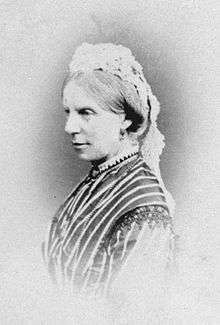Caroline Abraham
Caroline Harriet Abraham (née Palmer, 1809 – 17 June 1877) was born in Wanlip near Leicester. She became a New Zealand artist who created a useful record of that country in the nineteenth century. She was the influential wife of a bishop and the mother of another. She put together a book, with others, supporting Māori rights.
Caroline Abraham | |
|---|---|
 | |
| Born | Caroline Harriet Hudson 1809 Wanlip, Leicestershire, England |
| Died | 17 June 1877 (aged 67–68) Bournemouth, England |
| Known for | Watercolour artist; writer; wife of an Anglican bishop |
| Spouse(s) | |
| Relatives | Charles Palmer (father) Charles Abraham (son) |
Life
Caroline Harriet Palmer was born[1] and baptised in 1809 in Wanlip, Leicestershire, England.[2][3] She was the daughter of Sir Charles Thomas Hudson Palmer and his wife. Her father had changed his name from Hudson to Palmer in order to meet the terms of an inheritance.[1] In 1850 she married the Rev Charles Abraham and they emigrated to New Zealand shortly after where her husband wanted to work with George Selwyn.[2] They arrived in Auckland on 6 August 1850 with their servant.[4] Selwyn appointed her husband to lead a new college, St John's College, he had founded in Auckland. Her husband trained both Māori and European youths.[5]
Her husband was ordained to become the Bishop of Wellington whilst on a trip to England in 1857.[2] Her only son, Charles was born the same year and he went on to be the Bishop of Derby.

Abraham was a water colourist and her scenes of early New Zealand immigrant settlements are held by the National Library of New Zealand[7] and Auckland City[8][3] They are an important source of information from this period. During the New Zealand Wars she advocated for the Māori.[2]
The publication that she helped create was called Extracts of letters from New Zealand on the war question and it was published in 1861.[9] She wrote it with her aunt and uncle, George and Sarah Selwyn, her own husband and Sir William and Lady Mary Ann Martin. George Selwyn was a Bishop and Sir William Martin was the Chief Justice. Abraham believed that the Māori people (then called natives of New Zealand and similar) were a proud race whose rights needed to be considered. This book was distributed privately after being printed in London.[2]
In 1862 a set of eight matching lithographs were published which were based on images created by Abraham. The images built into a panorama of Tamaki showing the site of St John's Chapel and school buildings in Auckland. The lithography was achieved by an unnamed sister of Rev. William C. Cotton.[6]
In 1867 Abraham and her son returned to England in order for her son to study at Eton. Three years later, her husband also went back to England as his friend George Selwyn was to be made Bishop of Lichfield.[10]
Abraham died in Bournemouth in 1877.[5]
Legacy
She was the wife of a bishop and the mother of another.[2] Her paintings and sketches are held in several collections in New Zealand. One of her sketchbooks is in Auckland Public Library and this records the influence on her of classically trained, but New Zealand artists like Albin Martin and John Hoyte.[2]
References
| Wikimedia Commons has media related to Caroline Harriet Abraham. |
- Obituary, The Gentleman's Magazine, and Historical Chronicle, Volume 97, Part 1
- Kirker, Anne. "Caroline Harriet Abraham". Dictionary of New Zealand Biography. Ministry for Culture and Heritage. Retrieved 29 June 2014.
- Una Platts. "ABRAHAM, Caroline Harriet, nee Palmer c.1835–1877 | NZETC". Nzetc.victoria.ac.nz. Retrieved 13 May 2014.
- "Shipping Intelligence". New Zealander. 6 (450). 7 August 1850. p. 2. Retrieved 3 December 2015.
- W. G. D. Fletcher, 'Abraham, Charles John (1814–1903)', rev. H. C. G. Matthew, Oxford Dictionary of National Biography, Oxford University Press, 2004; online edn, Oct 2008 accessed 30 June 2014
- Panorama, natlib.govt.nz. Retrieved 29 June 2014
- "Abraham, Caroline Harriet, 1809?–1877 :Sketchbook. [1860–1864]". National Library of New Zealand. Retrieved 13 May 2014.
- "heritageimages Record". Aucklandcity.govt.nz. Retrieved 13 May 2014.
- "Extracts of letters from New Zealand on the war question ; with an article from the New Zealand Spectator of November 3rd, 1860 ; and a copy of the Native Offenders' Bill [electronic resource]". Europeana. Retrieved 30 June 2014.
- Macdonald, Charlotte (1991). The Book of New Zealand Women. Wellington: Bridget Williams Books. p. 2. ISBN 0908912048.